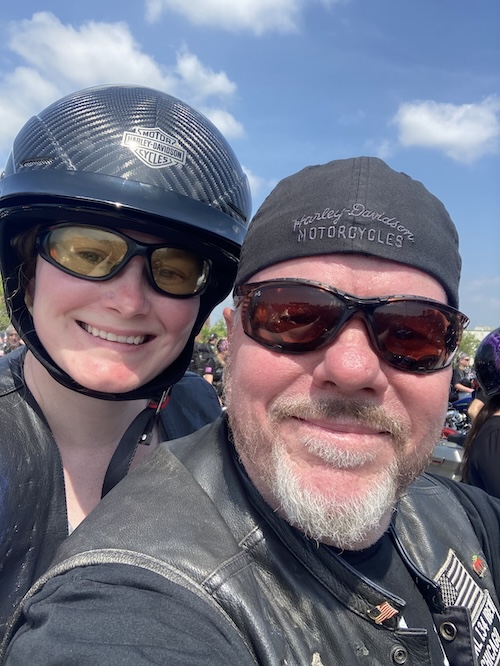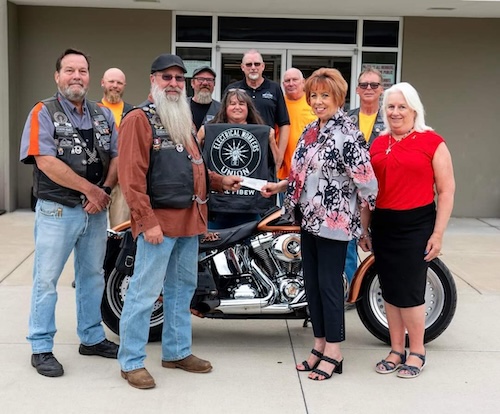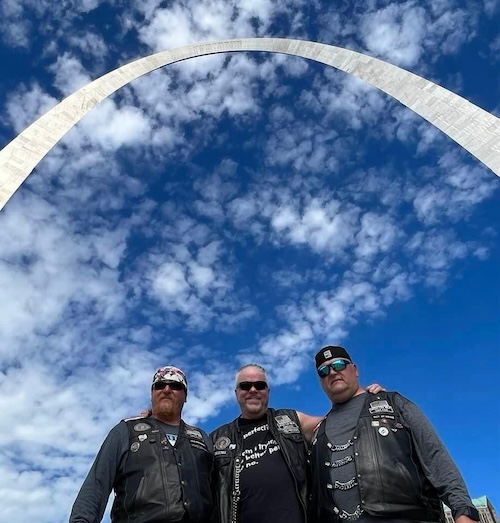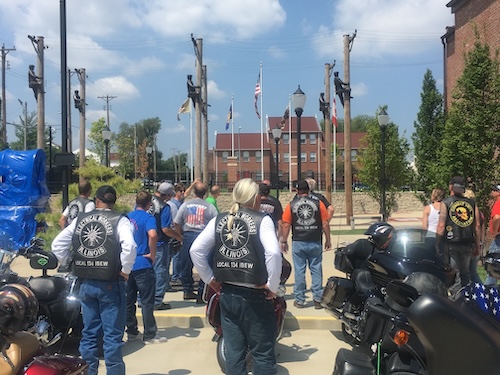There are a lot of ways to foster solidarity in a union, and one of the most fun — and loudest — is with a motorcycle club.

|
| Chicago Local 134’s riding club president Dean Hinderman, pictured with his daughter Samantha, put 5,000 miles on his bike last summer.
|

|
| Mike Crocker, St. Louis Local 1's riding club president, presents a check to the St. Louis Women's Safe House organization, one of two beneficiaries of the 2023 Midwest Solidarity Ride.
|

|
| Known as the “mother local of IBEW riding groups,” New York Local 3’s motorcycle club leads the city’s Labor Day parade down Fifth Avenue.
|

|
| Chicago Local 134 riders gather under St. Louis’ iconic Gateway Arch during the inaugural Midwest Solidarity Ride in 2022.
|

|
| Chicago Local 134 members take a moment to admire the lineman poles outside the IBEW’s Henry Miller Museum in St. Louis.
|
“It’s more about seeing your friends than anything else,” said Chicago Local 134 member Dean Hinderman. “No matter where you’re from or what your trade’s specialty is, we’re all just brothers and sisters when we go out riding.”
While IBEW members have likely been riding together for decades, official motorcycle clubs and groups didn’t come into being until 1995 when a few New York Local 3 members started one. Considered the “mother local of IBEW riding groups,” it now counts almost 200 members among its ranks, said Stan Stade, a Local 3 retiree and the club’s treasurer. Their motto: Honor, Integrity, Brotherhood.
“It’s unlike anything else in the entire union,” said Stade, who handles the patches that locals get, usually with the time-honored lightning bolts and the local’s state or number. “These clubs bring together brothers and sisters from all different backgrounds and expose them to all the aspects of this great organization. It’s a true example of brotherhood.”
Those early club days owe a debt to former International President Edwin D. Hill, who by all accounts had a big influence on how they grew into what they are now, including having a hand in designing the original patch.
“Ed was a mainstay in the East Coast,” Stade said. “It’s good to see that there’s a new regime now who’s picking up the ball.”
Today there are more than 50 clubs in the U.S. and three in Canada, though each of those are comprised of multiple locals from their respective provinces. East Coast rides that started with about 20 participants were getting close to 500 just before the pandemic.
The Midwest Solidarity Ride, held at the end of July, had 100 motorcycles last year, with about 140 participants from close to 20 locals, all riding together through the Ozarks despite 100-degree heat. Hosted jointly by St. Louis Local 1 and Kansas City, Mo., Local 53, the event was the second unionwide ride in the Midwest. The first took place in the IBEW’s hometown of St. Louis in 2022.
“It was such an amazing feeling to ride side-by-side with so many brothers and sisters all sharing the same passion for riding,” said Local 1 Business Representative Chuck DeMoulin, who serves as the riding club’s treasurer. “Knowing that we were raising money to help others in need only made it all the more special.”
A staple of just about every ride, whether local, national or international, is the fundraising component. The hosting local chooses a charity, often a local nonprofit, and raises funds through rider registration fees and sometimes other avenues like selling shirts or other swag. Last year’s Midwest ride collected close to $9,000, which was split between the Ronald McDonald House in Kansas City, Mo., and The Women’s Safe House, a domestic violence shelter in St. Louis.
“They were ecstatic when we told them,” Local 53 member Chad McGregor, who helped set up the ride, said of the Ronald McDonald House. “They said their beds have been full for months, so this money will really help with their costs.”
Charity runs have long been a part of the IBEW riding community, said Edmonton, Alberta, Local 424 retiree Ray MacNeil, who also serves as the national president for riding groups in the First District.
“It used to be that bikers could tell you where all the bootleg liquor was. Now it’s ice cream shops and charity fundraisers,” said MacNeil, who received his 50-year pin in September.
MacNeil, who helped form the Alberta Crew, which has members from Local 424 and Local 1007 in Edmonton, took part in the first annual Canadian ride, held in Moose Jaw, Saskatchewan, just before the Midwest event this year. While it didn’t attract as many members as its U.S. counterpart, MacNeil said there’s no shortage of interest on his side of the border and he’s working with locals across the country to set up charters of their own.
“It keeps me involved in the IBEW even though I’m retired,” he said. “The union and the motorcycle rides are a big part of who I am. Besides, you never really retire from the IBEW. Not entirely.”
Being able to share that identity, as a rider and an IBEW member, is perhaps the biggest draw of the clubs. It’s an opportunity to feel the freedom of the road alongside the solidarity of the Brotherhood. And unlike more formal IBEW meetings, the motorcycle rides are purely social.
“It’s a golden opportunity to get off the jobsites and away from the stress, never mind about jurisdictions or any of that, and do something you love, all while supporting a good cause,” MacNeil said. “That’s not bad for a bunch of IBEW members on motorcycles.”
Like MacNeil, Hinderman said he plans to keep up his involvement in the motorcycle rides even after he retires this year.
“They’ve reawakened a spirit in me,” said Hinderman, who put 5,000 miles on his bike last summer. “These rides are some of the best things I’ve done in my 40 years in Local 134.”
For a lot of members, the rides are an opportunity to meet people from other locals and trades who they may have never met otherwise. It’s a way to see the breadth of the union, or as Hinderman put it, it’s like an open house for locals.
“We welcome everyone’s idiosyncrasies and sense of humor,” he said. “We don’t ask anybody about their politics. Everybody just gets to be themselves.”
Having a chance to get to know brothers and sisters from places members may have never been to, and share a piece of the road and a meal afterward, can be a great way to strengthen ties of the union.
“New York City has its own feel, its own way of being and doing things. Then you meet West Virginia locals and see how they’re different, how they do things. But it’s all for solidarity. That’s the catalyst,” Stade said.
Local rides, between the bigger annual events, are an especially convenient way to keep that feeling alive all year long. Some locals have a ride almost every weekend, often attended by other locals. The only problem is squeezing them all in, said retired Local 3 Business Representative Jim Bua, who’s been around since the beginning of Local 3’s club and serves as an adviser.
“A lot of times, after working all day, you go home, you’re tired, you don’t always feel connected to the union. But on a run, you’re all the same. It brings everybody together,” he said. “It’s a reminder that you’re not alone, that there are people like you who have the same hobbies. It’s a great melting pot, just like the IBEW.”
Hosting duties for this year’s Midwest ride have been passed to Local 134, and the planning is already underway. Hinderman said they’re working on a map that will list where all the riding clubs are and an app that will connect the lead rider with the one who rides at the tail, a part of how the rides keep everyone together and safe. Among other features, the app will give them a quick and easy way to stay in touch in case anyone needs anything.
“It’s all about safety,” he said. “Your brothers are always watching out for you. You won’t fall down without being caught.”
Last year’s Canadian ride will take its members to picturesque Banff in the Rocky Mountains.
“It’s Ed Hill’s vision coming through,” MacNeil said. “We’re spreading further and further throughout the U.S. and Canada. It goes back to what Henry Miller had in mind, too. I’d like to think that if he were around today, he’d ride a Harley.”
The rides also serve as a de facto advertisement for the IBEW, and an impressive one at that, with members all riding together sporting their IBEW patches — union-made, of course. It’s not unusual to have passersby honk their horns or shout “Go union!” as the rumbling crews ride by.
“I always get this feeling of awe when I see motorcycles for as far as the eye can see,” said Local 1 member Mike Crocker, who serves as his club’s president. “It’s pretty cool when you see people coming out of their houses and businesses to get a look at us and wave at all the motorcycles.”
The bigger rides, like the Midwest Solidarity Ride, also come with offroad opportunities to get to know one another. Last year’s ride included a stop for lunch at Redd’s BBQ and Saloon, owned by a Local 53 member, and a banquet dinner with a raffle and prizes. Local 134 took home the award for having the most members, and MacNeil, who rode over 1,700 miles from Alberta, won the prize for having traveled the farthest. It’s also something he did almost entirely in attire more commonly associated with the beach than a bike.
“I would say that about 4,000 miles out of my 5,107 this summer was in shorts, a t-shirt and flip-flops,” he said. “Even when it was it raining.”
For MacNeil, and no doubt a lot of other riders, there’s no such thing as a bad day on a bike.
“There isn’t anything I don’t love about it,” said the third-generation member, who’s ridden through every state and province. ”Getting out in the air, the feeling of freedom. I’m more comfortable on my Harley than I am in my car.”
Hinderman noted that even when they were at a nice hotel with a pool, they opted for sticking close to their bikes.
“We’re not really hang-out-by-the pool types,” he said. “We’re more hang-out-in-the-parking-lot guys.”
Perhaps it’s not surprising that a union and a motorcycle club gel so well together. They’re both about solidarity and watching out for one another. And especially with a motorcycle ride, it can be a magnificent way to spend the day.
“It’s a great experience. After a day of riding, you get to relax and have a meal with your friends, old and new, and sit around and tell stories,” McGregor said. “Not that all of them are true.”